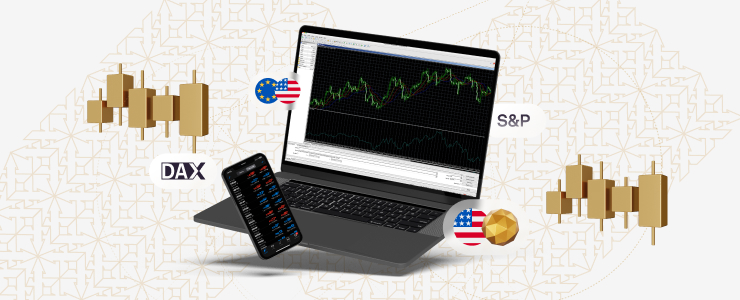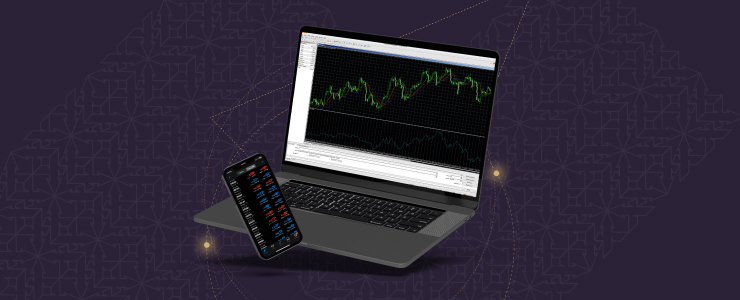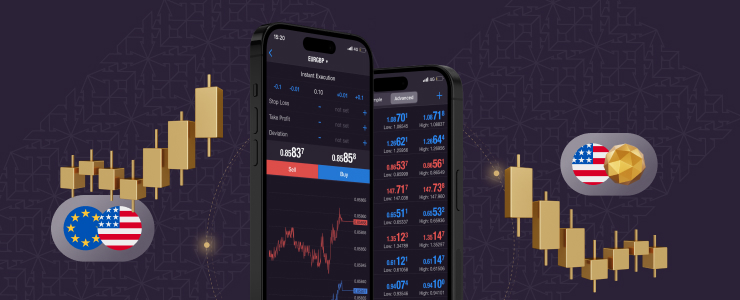Tous les traders commencent quelque part, et pour la plupart, c’est avec un compte de trading démo. Un compte démo est comme un environnement virtuel qui permet à chaque trader d’explorer les plateformes de trading, de tester des stratégies et d’apprendre sans risquer de perdre de l’argent réel. À terme, vous devrez envisager de passer à un compte forex réel, où chaque décision de trading que vous prenez peut avoir des conséquences financières et émotionnelles.
Il est essentiel de comprendre quand et comment effectuer cette transition. Dans cet article, nous explorons les principales différences entre un compte démo et un compte réel, notamment en matière d’exécution, de gestion des risques, de contrôle émotionnel, etc. Nous expliquons également comment rendre votre expérience de démonstration plus réaliste et à quel moment vous pouvez être prêt à trader en direct avec du capital réel.

Fonds virtuels vs capital réel dans les comptes Forex démo et réels
Un compte démo permet aux traders d’accéder à de l’argent virtuel afin qu’ils puissent s’entraîner à mettre en œuvre des stratégies et se familiariser avec les plateformes sans avoir à se soucier de perdre de l’argent. Il utilise des données de marché en direct ou en temps quasi réel pour donner l’impression de trader sans aucun enjeu.
En revanche, un compte Forex réel nécessite de l’argent réel. Cela signifie que les profits et les pertes deviennent réels. Par conséquent, chaque transaction entraîne des conséquences émotionnelles et financières beaucoup plus importantes.
Comptes Forex : trading démo et réel – spreads, slippage et exécution
Les spreads artificiellement bas, voire nuls, et l’exécution instantanée sont souvent proposés dans les comptes Forex démo. De plus, il n’y a jamais de slippage ni de recotation, ce qui rend le trading démo plus fluide.
Les comptes réels fonctionnent dans des conditions de marché réelles. Les spreads fluctuent, en particulier en période de volatilité du marché, des dérapages peuvent se produire et, si la liquidité est faible, les ordres peuvent être partiellement exécutés ou réévalués.
Environnement sans risque et charge émotionnelle
Avec un compte démo, vous ne ressentirez pas de pression émotionnelle. Il n’y a pas d’argent à perdre, donc les décisions sont généralement rationnelles. Cependant, l’absence de pression peut créer un faux sentiment de confiance.
Lorsque vous négociez en direct, les émotions liées au trading telles que la cupidité, la peur, l’hésitation ou l’excès de confiance sont bien réelles et peuvent nuire à un bon plan de trading. Les comptes réels exigent une discipline psychologique et une grande maîtrise de soi.
Les comptes démo vous permettent de tester différentes stratégies, plateformes de trading et outils dans un environnement sans risque. Si vous êtes débutant, c’est un outil idéal pour acquérir les compétences de base. Si vous êtes un trader expérimenté, en revanche, cela vous sera utile pour tester des idées de trading ou les fonctionnalités de la plateforme.
Les comptes réels exigent que vous fassiez preuve de discipline sous pression. Dans ce cas, les méthodes de gestion des risques telles que le dimensionnement des positions et les ordres stop loss deviennent cruciales, car vos stratégies sont mises à l’épreuve dans des conditions de marché réelles.
Gestion des risques : facultative ou indispensable pour les comptes Forex ?
Approfondissons la gestion des risques mentionnée ci-dessus. Dans les comptes Forex de démonstration, de nombreux traders adoptent une approche détendue en matière de gestion des risques. Comme aucun argent réel n’est en jeu, les traders prennent souvent des positions plus importantes, ignorent les ordres stop-loss ou négligent les paramètres de risque clés. Bien que cela puisse accélérer l’apprentissage ou l’expérimentation, cela ne reflète pas la discipline requise pour le trading en direct.
En revanche, la gestion des risques devient essentielle dans les comptes Forex réels. Chaque transaction a des conséquences financières réelles et, sans une gestion des risques appropriée, notamment en termes de taille des positions, de placement des ordres stop-loss et d’analyse du rapport risque/récompense, vous pouvez subir des pertes. Si vous maintenez un plan de gestion des risques solide et cohérent, votre survie à long terme et vos performances sur le marché réel pourraient s’améliorer.

Liquidité, coûts de négociation et frais
Une autre différence réside dans le fait que, dans les comptes démo, il n’y a aucune limite en matière de liquidité, même dans des conditions de faible volume. Cela s’explique par le fait que les transactions sont exécutées en interne et non sur le marché ouvert.
Cependant, les comptes réels interagissent avec la profondeur réelle du marché et les contreparties. Des risques tels que les exécutions partielles, les dérapages et les recotations existent, en particulier lorsque les marchés évoluent rapidement ou que la liquidité est élevée.
Dans le trading démo, il n’y a généralement pas de coûts réels. Les spreads sont minimes et les swaps et commissions peuvent même être inexistants. Cela donne une vision plus claire des bénéfices nets. Dans un environnement de trading réel, cependant, il existe des coûts de trading, notamment des spreads, des commissions et des frais de swap, qui ont un impact direct sur vos profits et vos pertes. Tous ces coûts peuvent s’accumuler et doivent être pris en compte lors de la planification de votre stratégie, en particulier si vous êtes un trader à haute fréquence.
Conditions du marché : simulées ou imprévisibles
Cette différence réside dans la manière dont les conditions du marché sont perçues. Les comptes démo peuvent utiliser des prix réels ou différés, mais ils simulent souvent des environnements de trading idéaux avec une exécution stable et un comportement prévisible. Ces conditions sont moins affectées par l’actualité en temps réel, la volatilité extrême ou la profondeur du marché.
Néanmoins, les traders qui utilisent des comptes réels sont exposés à la dynamique réelle du marché, où il existe des fluctuations de prix, des changements de volatilité inattendus ainsi que des mouvements liés à l’actualité qui peuvent influencer l’exécution des ordres et les résultats des transactions. Pour faire face à cette imprévisibilité, les traders doivent rester vigilants, être capables de s’adapter et se préparer à la nature très volatile des marchés forex en direct.
Quand passer de la démo à la version finale ?
Performances constantes dans le temps
Si vous avez réalisé des transactions efficaces dans un environnement de démonstration de manière constante, pendant plusieurs mois et dans différentes conditions de marché, le moment est peut-être venu d’envisager de passer à un compte réel.
Contrôle émotionnel
Êtes-vous capable de respecter les règles de trading que vous vous êtes fixées sans commettre d’erreurs impulsives et malgré des profits ou des pertes fictifs ? Si oui, vous êtes peut-être psychologiquement prêt pour le trading en direct. Si vos émotions continuent d’interférer avec votre trading, attendez avant de passer à un compte réel.
Gestion rigoureuse des risques
Si vous êtes à l’aise avec la définition de stop-loss, la gestion des tailles de lots et le respect des limites de risque par transaction, qui sont généralement de 1 à 2 % de votre compte, alors vous disposez d’outils essentiels pour trader avec de l’argent réel.
Montant adéquat du capital
Vous devriez toujours négocier ce que vous pouvez vous permettre de perdre. Commencez avec un capital modeste, peut-être des micro-lots, jusqu’à ce que vous vous sentiez à l’aise avec une exposition réelle.

Comment un compte démo Forex peut sembler plus réaliste
- Attendez-vous à une exécution imparfaite – Ne partez pas du principe que les transactions seront toujours exécutées instantanément ou à des prix idéaux, même si la démo offre des conditions idéales.
- Utilisez des fonds virtuels réalistes – Ne négocier qu’avec le montant que vous prévoyez d’utiliser pour vos transactions réelles. De cette façon, vous simulerez correctement le stress.
- Respectez vos règles de trading – Traitez chaque transaction, y compris les pertes, avec sérieux, même sur un compte démo. Récompensez votre discipline et tirez les leçons de vos erreurs.
Dernières réflexions
Les comptes démo et réels ont des objectifs différents mais complémentaires. Les comptes démo sont très utiles pour apprendre, tester et acquérir des compétences fondamentales. Cependant, ils ne peuvent pas reproduire la pression émotionnelle, les coûts réels et les défis liés à la liquidité que présente le trading réel. Le passage à un compte réel est une étape importante, mais elle doit être franchie lorsque vous êtes vraiment prêt.
Utilisez un compte démo pour acquérir des connaissances. Utilisez un compte réel pour développer votre résilience. Tradez judicieusement, restez discipliné et respectez les conditions de trading avec de l’argent réel.
Xlence propose une gamme d’options de compte conçues pour répondre à vos besoins à chaque étape. Commencez avec le compte Xlence Essential, qui offre un effet de levier flexible et des spreads compétitifs. Il est conçu aussi bien pour les traders débutants que pour les traders expérimentés.
Une fois familiarisé avec le système, vous avez la possibilité de passer à Xlence Prime, Xlence Deluxe ou Xlence Ultimate pour bénéficier de spreads encore plus bas, de fonctionnalités supplémentaires et d’un accès à un gestionnaire de compte dédié. Tous ces comptes sont sans commission et proposent des lots à partir de 0,01. Ils prennent en charge les mises à niveau sans swap, ce qui vous permet d’éviter les frais d’intérêt au jour le jour tout en restant conforme à la charia.
Avertissement : Ces informations ne constituent pas un conseil en investissement ni une recommandation d’investissement, mais une communication marketing.




